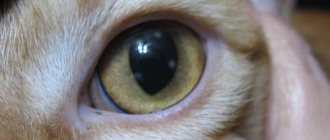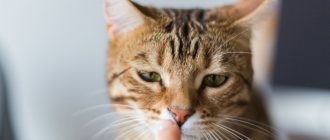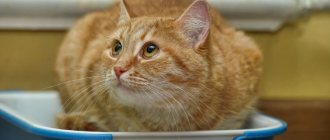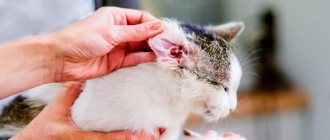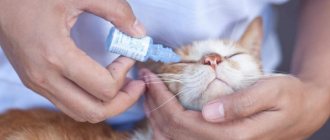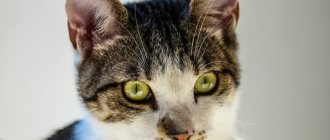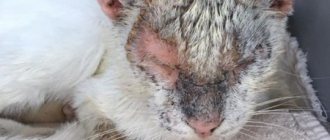Cats and cats can often experience inflammation in the oral cavity, which over time turns into stomatitis. In this case, inflammation can affect not only the gums, but also the mucous membranes of the cheeks, tongue, and palate.
Representatives of the cat family, unlike people, have a huge number of pathogenic bacteria and infections in their oral cavity. It is enough just for a small wound to appear on the mucous membrane of the gums and palate, and the infection, along with saliva, will quickly penetrate deep into the tissues. And this subsequently provokes extensive stomatitis in cats.
Causes of the disease
In veterinary medicine, stomatitis is understood as a group of inflammatory diseases of the mucous membrane, tongue, and periodontal areas. Pathology can occur in two forms - primary and secondary.
Factors that provoke primary stomatitis include:
- poor oral hygiene;
- injuries to the oral mucosa, for example, when eating tubular bones;
- eating food that is too hot or cold;
- burns of the mucous membrane resulting from contact with aggressive substances, detergents, etc.
Among the causes of secondary stomatitis, veterinarians identify:
- viruses that have entered the body;
- hormonal disorders;
- diabetes;
- infectious diseases.
Stomatitis can develop in any cat, regardless of age and gender; representatives of short-nosed breeds (Persians, exotics) are most susceptible to inflammatory processes in the oral cavity. This is explained by the specific structure of the muzzle.
Stomatitis in kittens and its treatment
Stomatitis in a kitten can occur due to severe stress. In addition, the pathological process can manifest itself against the background of poor nutrition, poor care, and failure to keep the pet’s oral cavity clean. All this has a negative effect on the oral mucosa.
Attention! Stomatitis in kittens can occur during the period of tooth change, when food debris accumulates between old and new teeth. In this case, the dental units themselves become covered with a layer of plaque.
Recommendations for the treatment of stomatitis in kittens:
- regular cleaning of teeth and mouth;
- Be sure to give your pet medications containing calcium and vitamin D3;
- If signs of stomatitis are detected, you should immediately contact a veterinarian;
- All medications and their use should only be prescribed by a specialist.
Main symptoms
At the initial stage, stomatitis in a cat is almost impossible to detect, since it is asymptomatic. If there is something alarming about your pet's behavior, you can examine its mouth. Swelling, red, inflamed mucous membranes and ulcers are a serious reason to take the animal to a veterinary clinic for examination.
Another characteristic sign that suggests stomatitis is hypersalivation. The cat drools profusely, the fur on its face, chest and even belly is constantly wet, which gives the animal an unkempt, disheveled appearance.
Inflammations and ulcers cause the pet considerable discomfort, and you can notice that he constantly washes himself and rubs his paw in the muzzle area, as if trying to free himself from a foreign object.
The behavior of your four-legged pet is changing. He becomes lethargic, inactive, drinks a lot and eats little, even refusing his favorite treats.
As the disease progresses, the pet's condition worsens. One cannot help but notice the strong smell of rotten meat from the mouth, weight loss due to complete refusal of food, enlarged lymph nodes under the lower jaw, the release of ichor and pus along with saliva, swelling and swelling of the lips. In severe cases, the temperature may rise and teeth may fall out.
Types of stomatitis
Stomatitis in cats occurs in several forms. Moreover, each type has certain characteristics. So, the following types of inflammatory process of the oral cavity in cats are distinguished:
- Catarrhal appearance. This type of stomatitis is considered quite common. It is the beginning of complications that arise when timely and adequate treatment is not provided;
- Ulcerative variety . During it, small ulcers form on the surface of the oral mucosa, namely the gums, palate, tongue, and lips. Lesions may vary in depth and extent of distribution;
- Papillomatous . This variety can arise as a result of the active activity of the papilloma virus in the cat’s body. Also called viral stomatitis;
- Gangrenous stomatitis in cats . During this form, animals experience death of the oral mucosa. Gangrenes pose a high health risk because they lead to sepsis and further death of the pet. With this form, a fetid and unpleasant odor is observed from the animal’s mouth. Often, gangrenous stomatitis is accompanied by a feverish state and enlarged submandibular lymph nodes;
- Phlegmous stomatitis. With this type, pus appears under the first thin layer of mucosa, which spreads over large areas. Over time, it leads to the appearance of sepsis. The pink color of the mucous membrane changes over time to gray or bluish. When puncturing the affected areas, pus is discharged;
- Autoimmune (immune-mediated feline stomatitis or chronic lymphocytic gingivostomatitis). The inflammatory process in this form develops against the background of the body’s rejection of teeth. Obvious symptoms of the inflammatory process develop right around the dental accords. This condition is greatly complicated by the fact that over time, penetration of an infectious agent into the oral cavity is observed. Therapeutic therapy is accompanied by the complete removal of all of the pet’s teeth.
Treatment, prognosis
Treatment can be conservative (medication), surgical or combined.
Surgical treatment is carried out in severe cases when the mucous membrane has undergone destructive changes without the possibility of recovery. Gangrenous areas will prevent healthy tissue from healing. Often, a specialist also has to remove teeth (in case of autoimmune stomatitis), choosing this method as the only one capable of saving the animal’s life.
A combined treatment method involves surgical cleaning of the oral cavity, removal of certain teeth that are no longer possible to save, and drug therapy.
Medication assistance includes the following steps:
- cleaning the oral mucosa from traces of tissue decay and pus;
- elimination of the source of infection (with secondary stomatitis);
- healing of affected areas of the mucosa;
- strengthening the immune system.
To disinfect the oral cavity and treat ulcers directly, drugs such as Lugol spray, or Lugol's solution with glycerin, Chlorhexidine, Dentavedin gels, Metrogyl, Protargol solution are most often used.
Important: Veterinarians prefer not to use Rotocan, as it provokes hypersalivation.
To eliminate infection and relieve inflammation, antiviral, antifungal, antimicrobial drugs, as well as antibiotics are used.
As for the forecasts, for the most part they are favorable. If the visit to the veterinary clinic was timely, and the treatment was competent and consistent, then it is possible to achieve a complete cure for the animal.
Diagnostics
Diagnosis should only be carried out in a veterinary clinic. This is due to the fact that the disease has many subforms and causes that cause it.
In addition, the pathology is very painful, so in some cases, examination and treatment procedures are only possible under local or general anesthesia. In some cases, it may be necessary to hospitalize the animal, remove teeth, or perform surgical operations.
The set of diagnostic measures includes:
- Anamnesis collection. Possible causes of the pathology are identified.
- Visual examination of the oral cavity. The nature and extent of the damage is determined.
- Rinse from the oral mucosa followed by culture of secretions.
- Blood chemistry.
- Analysis of urine.
- Test for viral infection.
Based on the diagnostic results, a decision is made on treatment methods and the need for inpatient care.
What to do at home
The owner must strictly follow the veterinarian's instructions. It is prohibited to prescribe medications yourself, increase or decrease their dosage! Some pet owners prefer not to go to a veterinary clinic and treat their pets with folk remedies.
It is not forbidden to use decoctions of medicinal herbs (sage, chamomile, oak bark, etc.), but they should be used as an addition to traditional treatment.
A disease as serious as stomatitis requires adjustments in diet. The diet should be enriched with nutrients and consist of liquid and semi-liquid foods. Chicken and beef broths, pureed soups, and pureed porridges are ideal.
It should be taken into account that a weakened cat, experiencing pain and discomfort when eating, will refuse to eat.
In this case, you should force feed, introducing food into your mouth using a syringe. You need to act carefully so that the animal does not choke.
Nutrition for cats suffering from stomatitis
For a quick recovery, Aibolit advise switching a sick pet exclusively to liquid feeding. Brew your cat beef or chicken broths and soups. Give him pureed porridge and milk. If the pet refuses to eat on its own, the food should be poured into the mouth with a syringe. This should be done especially carefully so that the purr does not choke, and the mucous membranes of its oral cavity are not further injured. The animal should be fed in a similar manner so that dehydration does not complicate the healing process.
Prevention
In order to prevent stomatitis in your beloved animal, you should adhere to certain rules. First of all, pay close attention to the pet’s hygiene. Veterinary stores sell special toothbrushes. By taking care of your teeth, you can reduce the likelihood of inflammatory processes in the oral cavity.
The cat's diet should be complete, excluding bones and cartilage, which can damage the teeth. It is worth paying more attention to the temperature of the food your animal eats.
One of the preventive measures is timely vaccination. Monitor your pet's health, do not delay visits to the veterinarian, take care of a nutritious diet, and your animal will thank you.
Application of ointment
Before applying Clotrimazole, clean the problem area with baby soap and water and dry thoroughly. The towel used must be disinfected. The drug is used to treat several pathological processes:
- Thrush
Candidiasis affects the mucous membranes of the body. When the genital form develops in women, the drug is applied using a special applicator; upon completion of the procedure, the patient must remain in a supine position for at least half an hour. Both external and internal genitalia are treated. Due to poor distribution of the ointment over the skin surface, Clotrimazole cream or vaginal suppositories are more often used. Therapy is carried out for up to 30 days.
For men, weekly manipulations with the medicine are enough to combat candidiasis. The medication is applied to the mucous membranes affected by the fungus and rubbed in gently. If one of the sexual partners is infected, the other automatically undergoes preventive therapy, even in the absence of obvious symptoms.
- Fungal infection of nails and feet
When applying the product, not only the lesion is captured, but also the nearby healthy skin. After careful rubbing, linen or cotton socks are put on the feet, and the inner surface of the shoes is treated for prevention.
Nail plates are treated with Clotrimazole solution; they are cut short before treatment. Therapeutic measures take place over 1-2 months, supplemented by one week of prophylaxis.
- Depriving
The drug is prescribed to combat the ringworm, pityriasis type of pathology. Surfaces affected by the fungus are treated evenly, and additional disinfectants are used: iodine solution, etc. In difficult cases, therapy is supplemented with fungicides for oral administration. Treatment is carried out three times a day for 3 weeks. After completion of the course, preventive treatment continues for another 5 days.
- Dermatitis
Clotrimazole is active against atopic, seborrheic, and diaper dermatitis. In the first case, the ointment is used:
- for the face – three times a day;
- for the scalp – 2 times a day.
For babies, the drug is applied once every 24 hours. Therapy takes up to one calendar month, prevention of relapses takes another 5-7 days. For atopic dermatitis, the medicine is included in complex treatment with other medications. The diaper form of the pathology allows treatment within 5 days. Additional medications may be used.
Caring for a cat when sick
When diagnosing stomatitis in a cat, you need to exclude hot and cold foods so that the inflamed area of the mucous membrane is not irritated.
Due to the fact that stomatitis affects large areas of the oral mucosa, the owner should take care of preparing food for his beloved pet in ground or liquid form. To eliminate the infection, the animal must be given clean water frequently.
If inflammation is detected and before visiting the veterinarian, you can alleviate the animal’s condition at home by irrigating the oral cavity with a soda solution or water with the addition of hydrogen peroxide. Additionally, you can use a decoction of oak bark.
Preventive measures
It is, of course, impossible to completely exclude the occurrence of stomatitis, but it is necessary to minimize the factors that provoke its occurrence and development.
The owner will need:
- avoid the presence of sharp bones in food;
- monitor the temperature of the cat food (it should be slightly above room temperature);
- do not pour cold water into the drinking bowl;
- remove household/garden chemicals from the cat;
- get rid of poisonous indoor plants.
To maintain general immunity, you will need to take your cat for routine vaccination.
Return to content
Indications and contraindications for use
The list of pathologies for which the ointment is recommended is presented:
- genital candidiasis complicated by trichomoniasis;
- dermatomycosis;
- dermatophytosis;
- mycoses complicated by infection of pyogenic cocci.
- thrush;
- some types of lichen;
- paronychia;
- superficial candidiasis;
- stomatitis;
- erythrasma.
The drug is contraindicated:
- in the first trimester of pregnancy;
- for abrasions, wounds, skin erosions;
- intolerance to component components.
Use in the second and third semesters of pregnancy requires the permission of a doctor; during lactation, it is prohibited to apply the ointment to the breast. The medicine is prescribed to newborns with restrictions:
- A small area of skin is subjected to the procedure;
- Large lesions are treated in parts.
The medication in the form of powder is prescribed to infants with an infected type of diaper rash. Treatment of fungal infections is important for pathologies that cause drying of the dermis.
